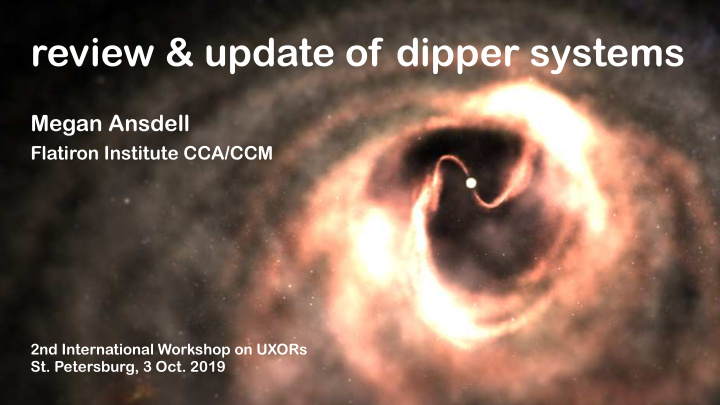



review & update of dipper systems Megan Ansdell Flatiron Institute CCA/CCM 2nd International Workshop on UXORs St. Petersburg, 3 Oct. 2019
what are “dippers” systems? exhibit dimming events 1.10 Normalized Flux 0.95 • deep (> 10 % in flux) 0.80 quasi-periodic • moderate-duration (1 day) 0.65 “AA Tau-like” • quasi-periodic or aperiodic EPIC 204137184 0.50 (QP ~ stellar rotation period) 1.05 Normalized Flux young stars + disks 1.00 0.95 • 1-10 Myr (normal) TTauri stars 0.90 quasi-periodic • common (30% of YSOs) EPIC 203937317 0.85 • host protoplanetary disks 1.05 Normalized Flux 1.00 CoRoT + K2 0.95 0.90 aperiodic 0.85 EPIC 205519771 0.80 2060 2080 2100 2120 2140 0.0 0.2 0.4 0.6 0.8 1.0 BJD-2454833 Phase Ansdell et al. 2016a
how are “dippers” different from UXORs? UXORs Dippers harder to explain with aperiodic ➜ PERIODICITY aperiodic single/unified mechanism? or quasi-periodic difficult to schedule ➜ DIP DURATION weeks - months 0.5 - 2 days simultaneous observations need space-based telescopes ➜ DIP DEPTH 1 - 3 mags 0.1 - 1 mags to detect variability more common, but fainter; STELLAR HOSTS Herbigs T Tauri stars ➜ harder follow up observing
what causes dippers? inclined B-field co-rotation radius McGinnis+2015 quasi-periodic aperiodic inner warp in edge-on accretion disk ➜ ➜ stable accretion unstable accretion nearly edge-on (70 deg) disk Bouvier+1999 Kurosawa & Romanova 2013
what causes dippers? • co-rotation radius > sublimation radius for low-mass (K/M-type) stars • co-rotation radius ~ B-field truncation radius allows material to flow up B-field lines • inclined B-field axis enables moderate disk inclinations to exhibit dipper behavior , 흻 , Ω , Ṁ acc to confirm need measurements of B Bodman+2017
most dippers are not significantly accreting Pa ɣ emission: •44% of K2 dippers •97% of CTTS (Edwards+06) most are WTTS based on H 흰 emission weak or no accretion based on Pa emission White & Basri 2003 Edwards+2006
are dipper disks really edge-on? Early search of ALMA archive suggested not by turning up face-on, edge-on, and intermediate inclination dipper disks Ansdell et al. 2016b ➜ J1604: misaligned inner disk from inclined companion Takami+2014, Pinilla+2018 Marino+2015 (HD152527)
measuring outer disk inclinations with ALMA GALARIO Tazarri+2018 GPU-accelerated Python library for fitting radio interferometry visibilities + ➜ uncertainties & posterior distributions emcee Forman-Mackey+2013 MCMC sampler in Python for Bayesian parameter estimation
24 dippers in USco & 흆 Oph Ansdelll (subm.) ➜ dippers found in K2 light curves Ansdell+2016a Hedges+2018 Cody & Hillenbrand 2018 + outer disks resolved by ALMA ALMA archive
dippers exhibit an isotropic i disk distribution MC sampling of posterior distributions Ansdell et al. (subm.)
accretion-driven disc warp vertical disc instability dusty disc winds broken inner disc EPIC i d 203937317 7 no resolved cavity 204638512 8 204281213 19 203770559 27 no resolved cavity 205345560 29 disc inclination too low 204630363 38 204864076 45 no resolved cavity multiple (+new) mechanisms 204176565 47 disc inclination too low 203936815 47 needed to explain dippers? 203950167 48 disc inclination too low 204142243 48 203962599 52 no resolved cavity 205151387 54 203860592 54 205238942 56 204489514 59 204514548 61 203895983 63 203843911 66 no resolved cavity 203824153 67 204399980 70 204211116 71 205080616 71 203850058 84 Ansdell et al. (subm.)
DSHARP observations of dipper disks Andrews et al. 2018, Huang et al. 2018
DSHARP observations of dipper disks Andrews et al. 2018, Huang et al. 2018 • diverse disk morphologies down to ~ 5au scales • diversity reflects larger DSHARP sample • other DSHARP disks with K2 light curves are not dippers
finding intermediate-aged dippers with TESS TESS covers the entire sky, including nearby YMGs (10- 150 Myr)
finding intermediate-aged dippers with TESS HD 240779 [1M ⦿ , 125 Myr] Gaidos et al. 2019 • many of the dipper mechanisms (e.g, accretion-driven inner disk warps) ruled out • can be explained by disrupted ~100 km planetesimal due to tides or stellar irradiation? • will give insight into final phase of rocky planet formation (30 TESS dippers already identified)
Summary • Dipper disks are not biased toward nearly edge-on inclinations • Dippers have an isotropic outer disk inclination distribution and exhibit a range of morphologies echoing the general disk population • This suggests that multiple mechanisms may be required to explain the dipper phenomenon (inner warps, disk winds, inclined planets) • More broady, this also suggests that the geometry and morpholoy outer disk is completely unrelated to the dynamic inner disk
Recommend
More recommend